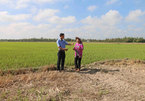with the highest level expected to be in February and March in Mekong River estuary and in March and April in Vam Co and Cai Lon rivers.
 |
|
Durian trees dying due to widespread saltwater intrusion
|
However, salt intrusion will be still more severe than the average of many years, said Phung Tien Dung, head of the Hydrological Forecasting Department for the Central, Central Highlands and Southern regions under the National Centre for Hydro-Meteorological Forecasting.
The situation will depend much on the water flows from upstream on the Mekong River and tides, with changes expected in the coming times, Dung stated.
He advised localities in the region to keep updated on hydro-meteorology forecasts and actively carry out measures to prevent and control saltwater intrusion.
The localities were also recommended to stock up on freshwater during low tides to serve agricultural production and daily activities of locals.
The water levels measured upstream Mekong River are currently 0.1-1.2 m lower than the many-year average, but downstream the levels are 0.1-0.2 m higher than average./.VNA

Mekong Delta should safeguard fruit orchards from saltwater in rivers: experts
The Mekong Delta region should take proactive measures to protect fruit orchards in the 2020 – 21 dry season as severe saltwater intrusion in rivers is forecast in the coming months, experts have said.

Tra Vinh loses $43m to saltwater intrusion, drought damage
Saltwater intrusion and drought in the Cuu Long (Mekong) Delta province of Tra Vinh caused a total damage of VND1 trillion (US$43 million) to agricultural production in the 2019-20 dry season.